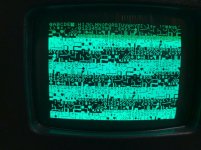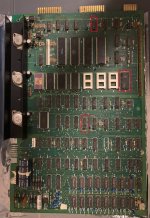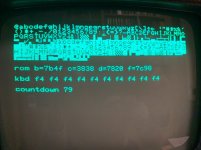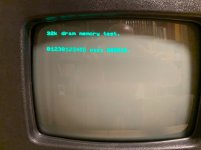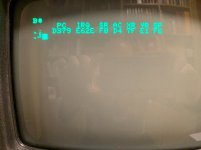Today it's a sad day for me, my CBM3032 shows a garbage screen and do not turns on  . I have to say that I'm not a technician, this is just a hobby for me and therefore I don't have oscilloscope, just a digital multimeter and a cheap logic probe. After reading lots of posts in the forum what I have done until now is:
. I have to say that I'm not a technician, this is just a hobby for me and therefore I don't have oscilloscope, just a digital multimeter and a cheap logic probe. After reading lots of posts in the forum what I have done until now is:
1) Checked voltage transformer outputs and all of them are correct as follows:
pins 4 and 5: 8,7v
pins 4 and 6: 17,4v
pins 5 and 6: 8,7v
pins 7 and 8: 16,6v
pins 9 and 10: 17v
2) Checked DC voltages in the PCB and all of them are correct as follows:
CR10 and CR11 anode: +4,9v DC
CR12 anode: +12,2v DC
CR13 anode: -5,0v DC
3) Measured the 6502 pins with the logic probe with the following results:
Pin 38 (SO): 1
Pin 2 (RDY): 1
Pin 6 (/NMI): 1
Pin 4 (/IRQ): 1
Pin 40 (/RESET): 0 at the startup and 1 after 1 second.
Pin 37: (PHIO): 0+1+PULSE in the probe turned ON
Pin 39 (PHI2): 0+1+PULSE in the probe turned ON
Pin 7 (SYNC): 0+1+PULSE in the probe turned ON
4) Released UC5, UC6 and UC7 and the garbage screen remains.
5) Set the Dave's PET TESTER chip in UD8 and the garbage screen remains.
6) Replaced 6502 by a good-one working in another board.
As far as I know, if the 6502 and the Kernal ROM are OK, the PET tester should start it isn't?
What else can I try?
Thank you
1) Checked voltage transformer outputs and all of them are correct as follows:
pins 4 and 5: 8,7v
pins 4 and 6: 17,4v
pins 5 and 6: 8,7v
pins 7 and 8: 16,6v
pins 9 and 10: 17v
2) Checked DC voltages in the PCB and all of them are correct as follows:
CR10 and CR11 anode: +4,9v DC
CR12 anode: +12,2v DC
CR13 anode: -5,0v DC
3) Measured the 6502 pins with the logic probe with the following results:
Pin 38 (SO): 1
Pin 2 (RDY): 1
Pin 6 (/NMI): 1
Pin 4 (/IRQ): 1
Pin 40 (/RESET): 0 at the startup and 1 after 1 second.
Pin 37: (PHIO): 0+1+PULSE in the probe turned ON
Pin 39 (PHI2): 0+1+PULSE in the probe turned ON
Pin 7 (SYNC): 0+1+PULSE in the probe turned ON
4) Released UC5, UC6 and UC7 and the garbage screen remains.
5) Set the Dave's PET TESTER chip in UD8 and the garbage screen remains.
6) Replaced 6502 by a good-one working in another board.
As far as I know, if the 6502 and the Kernal ROM are OK, the PET tester should start it isn't?
What else can I try?
Thank you

